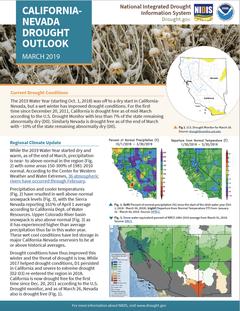California-Nevada Drought Outlook - March 2019
Current Drought Conditions
The 2019 Water Year (starting Oct. 1, 2018) was off to a dry start in California-Nevada, but a wet winter has improved drought conditions. For the first time since December 20, 2011, California is drought free as of mid-March according to the U.S. Drought Monitor with less than 7% of the state remaining abnormally dry (D0). Similarly Nevada is drought free as of the end of March with ~10% of the state remaining abnormally dry (D0).
Regional Climate Update
While the 2019 Water Year started dry and warm, as of the end of March, precipitation is near- to above-normal in the region with some areas 150-300% of 1981-2010 normal. According to the Center for Western Weather and Water Extremes, 36 atmospheric rivers have occurred through February.
Precipitation and cooler temperatures have resulted in well above-normal snowpack levels, with the Sierra Nevada reporting 161% of April 1 average according to California Dept. of Water Resources. Upper Colorado River basin snowpack is also above normal as it has experienced higher than average precipitation thus far in this water year. These wet cool conditions have led storage in major California-Nevada reservoirs to be at or above historical averages.
Drought conditions have thus improved this winter and the threat of drought is low. While 2017 helped drought conditions, D1 persisted in California and severe to extreme drought (D2-D3) re-entered the region in 2018. California is now drought free for the first time since Dec. 20, 2011 according to the U.S. Drought monitor, and as of March 26, Nevada also is drought free.
Drought & Climate Outlook
- ENSO: NOAA’s ENSO alert system status is currently an El Niño Advisory: Weak El Niño conditions are likely to continue through the 2019 Northern Hemisphere spring (~80% chance) and summer (~60% chance). For more information, check out the NOAA ENSO blog.
- Temperature: Warm temperatures are favored over northern California-Nevada through spring with >33% chance of above-normal April-June temperatures, with the greatest chances (>40%) further north (Fig. 4).
- Precipitation: Most of California and Nevada have equal chances of above, below, and normal precipitation for April - June (Fig. 4). Eastern Nevada has slightly increased odds of above normal precipitation. The water supply forecast is generally above normal in California-Nevada and the Colorado River Basin due to snowpack levels and temperature forecasts.
AgRisk Viewer
Available from the USDA Southwest Climate Hub, the AgRisk Viewer allows users to explore, visualize, and analyze publicly-available crop insurance data from the U.S. Department of Agriculture (USDA) Risk Management Agency (RMA) at the state or county spatial scale at monthly or annual timescales. Learn more: https://swclimatehub.info/rma/
Contributors:
Stephanie McAfee, UNR, Nevada Deputy State Climatologist
Peter Fickenscher, NOAA/NWS CA-NV River Forecast Center
Caiti Steele, USDA Southwest Climate Hub
Amanda Sheffield, NIDIS
About this Outlook
On March 25, 2019 NIDIS and its partners held this webinar as part of a series of drought and climate outlook webinars designed to provide stakeholders in the region with timely information on current drought status and impacts, as well as a preview of current and developing climatic events. A video of and presentations from this webinar can be accessed here.



